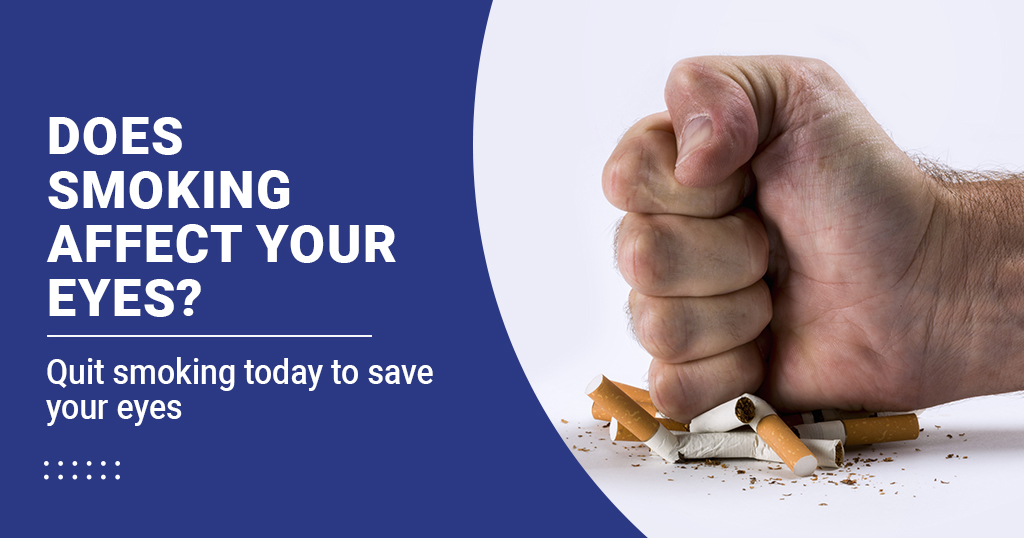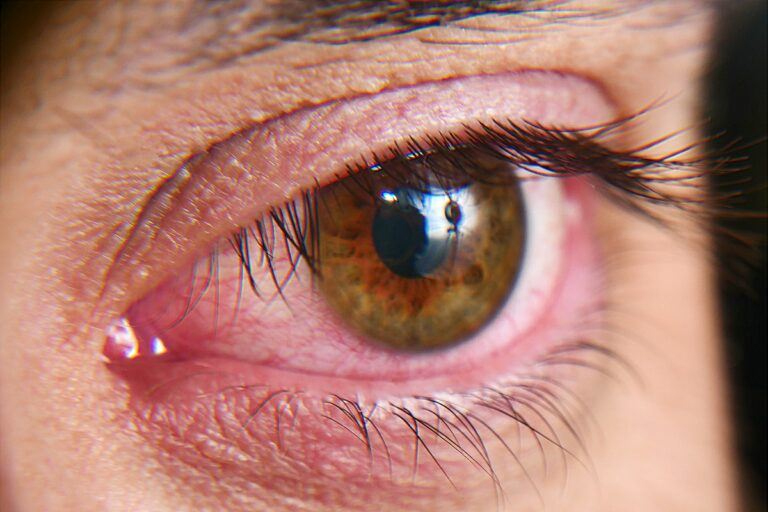Smoking Can Lead to Vision Loss or Blindness
- "Smoking Can Lead to Vision Loss or Blindness" is also available as a printable PDF (PDF, 128KB, 2pg.).


Smoking cigarettes affects many aspects of your body,
Eye Disease and Smoking:
Smoking has long been known to cause heart disease and lung cancer; however many people don't realize that smoking can lead to vision loss. Studies show smoking increases the risk of age-related macular degeneration, cataracts, glaucoma and diabetic retinopathy and Dry Eye Syndrome.
- Age Related Macular Degeneration (AMD)
- One way to reduce the risk of developing
AMD is by NOT smoking. Smokers are three to four times more likely to develop AMD than nonsmokers. Nonsmokers living with smokers almost double their risk of developing AMD.
- One way to reduce the risk of developing
- Cataract
- Heavy smokers (15 cigarettes/day or more) have up to three times the risk of cataract as nonsmokers.
- Glaucoma
- There is a strong link between smoking and high blood pressure, cataracts and diabetes all of which are risk factors for glaucoma.
- Diabetic Retinopathy
- Smoking can increase your chances of getting diabetes. It can also make managing diabetes more difficult for those who already have it. Complications of diabetes made worse by smoking include retinopathy, heart disease, stroke, vascular disease, kidney disease, nerve damage, foot problems and many others.
- Dry Eye Syndrome
- Dry Eye Syndrome is more than twice as likely to impact smokers as non-smokers.
What You Can Do to Prevent Vision Loss:
Healthy habits can lead to healthy eyes. The risk of eye disease and
vision loss can be lowered if you::
- Quit smoking!
- Eat healthy foods (including green leafy vegetables, fruits and foods high in vitamins C, E, and beta carotene).
- Control blood pressure and cholesterol.
- Stay active.
- Visit your eye care professional regularly.
Description of Eye Diseases Associated with Smoking:
1. Age Related Macular Degeneration (AMD):
AMD begins as a loss of central vision which makes it difficult to read and see fine details. Over time, vision loss increases significantly. Of the two types of AMD, "dry" and "wet," dry AMD is the most common. In dry AMD, fatty deposits form under the light-sensing cells in the back of the eye (retina). Vision loss in dry AMD usually gets worse slowly. In wet AMD, tiny blood vessels under the retina leak or break open. This changes vision and causes scar tissue to form. Wet AMD is less common, but more quickly harmful to vision.
2. Glaucoma
Glaucoma causes a gradual break down of the cells that make up the nerve in your eye that sends visual information to your brain (optic nerve). As the nerve cells die, vision is slowly lost, usually beginning with side vision. Often the loss of vision is not noticeable until a large amount of nerve damage has occurred. This is the reason why as many as half of all people with glaucoma may be unaware that they have it.
3. Cataract
Cataract is a clouding of the eye's naturally clear lens. It usually gets worse as we get older. Most cataracts are related to aging. Cataracts are very common in older people. By age 80, more than half of all Americans either have a cataract or have had cataract surgery.
Discontinuation of smoking shows a reduction in the risk of surgical cataract extraction, taking 10 to 20 years for the risk to reduce to that of non-smokers. decrease in progression of age related macular degeneration (AMD)
4. Diabetic retinopathy
Diabetic retinopathy is a common complication of diabetes. It affects the tiny blood vessels of the retina in the eye. Retinal blood vessels can break down, leak or become blocked and this can affect vision over time. In some people with diabetic retinopathy, serious damage to the eye can occur when new blood vessels grow on the surface o
f the retina.
5. Dry Eye Syndrome
Dry Eye Syndrome is an eye disease that appears as damaged blood vessels in the eye. This can lead to eye irritation, itchy and scratchy eyes, and burning sensation of the eyes.
6. Optic nerve problems
People who smoke risk having optic nerve problems. The optic nerve connects the eye to the brain. Damage to this nerve can lead to blindness.
Smoking can increase risk factors which can lead to glaucoma—a disease that affects the optic nerve.
7. Uveitis
Smoking can lead to a disease that affects part of the eye called
the uvea. This is the middle layer of the eye wall. Uveitis is when this layer becomes inflamed (red and swollen). This disease causes a red eye, pain and vision problems.
8. Graves’ disease
This is a disease of the body’s thyroid gland. One of the symptoms of Graves’ disease is bulging eyes. Smokers who have Graves’ disease risk having their eye condition get worse. They can also lose vision.
9 . Pregnant? Smoking can harm your baby’s eyes.
If you smoke while pregnant, your baby is 5 times more li
kely to get bacterial meningitis as a child. This is when tissues around the brain swell. Meningitis can cause eye infection(s) and other vision problems.
Also, smoking during pregnancy increases your risk for giving birth too early. Premature birth can lead to a serious eye problem called “retinopathy of prematurity.” The baby may have permanent vision loss or blindness.
Toddlers and children are also at risk from secondhand smoke—a new study suggests children as young as 6 years old already show signs of eye damage.
The American Cancer Society has resources to help people who want to quit smoking.
Avoiding smoking and second-hand smoke—or quitting if you are a smoker—are some of the best investments you can make in your long-term eye health.
VAPING Alternatives are Just as Bad as Smoking

Vaping is an alternative form of smoking that has grown in popularity with young adults. There is a mistaken assumption that vaping is not as dangerous or harmful as smoking tobacco or marijuana.
However, many of the same chemicals found in tobacco and marijuana can also be found in the “e-juice” used for vaping. Additionally, “e-juice” can contain other chemicals not found in tobacco or marijuana that could pose health risks.
Vaping involves heating up “e-juice” into vapor and then inhaling it. The vapor makes clouds of “smoke” much like regular smoking. Developing this habit could be a gateway to switching to tobacco or marijuana.
Over the past decade, eye care providers optometrists - ophthalmologists, and other researchers in Los Angeles have studied the effects of vaping on the eyes. If you vape, it is important to understand and know the short-term and long-term side effects of vaping on your eyes.
Vaping can cause dry eye.
One short-term side effect is the development of dry eye. This is where the eyes do not produce sufficient moisture to keep the eyes wet. You may notice your eyes feel scratchy or itchy, are red, or hurt when you blink. You may also notice a sensitivity to light.
Dry eye is treatable with prescription eye drops to lubricate the eyes and keep the
m moist. However, this should be used as a temporary solution while working on quitting vaping.
Vaping can cause oxidative stress in the eyes.
This condition can occur when there is an imbalance in oxygen levels. The added stress in the eyes is not healthy. Over time, it can increase the risk of cataracts, macular degeneration, and glaucoma.
Vaping can increase the risks of macular degeneration.
Macular degeneration tends to occur later in life. Vaping can increase the risk of this condition developing sooner in some people. The condition can either cause the retina to deteriorate (dry macular degeneration) or result in excess blood vessels growing under the retina (wet macular degeneration).
Vaping can increase the development of cataracts.
Almost everyone will develop cataracts at some point in their lifetime. Cataracts are a clouding of the natural lens in the eye that reduces vision and leads to temporary blindness if left untreated.
Most people do not start to develop them until their late 60s or older. However, the development of cataracts can be sooner in people who vape regularly, as can happen with people who smoke.
Vaping can increase the development of glaucoma.
There are several different types of glaucoma that can develop, which typically occurs later in life. Yet again, vaping can increase the risk of glaucoma developing sooner. Glaucoma is another eye condition that reduces vision and, if left untreated, can lead to permanent blindness.
To determine the effects of smoking and other health conditions that can have a direct impact on your eye health call the doctors at Hopewell Lambertville Eye (www.seelife.net)
Hopewell Eye: 84 East Broad St, Hopewell, NJ 08525 609-466-0055
Lambertville Eye: 16 South Franklin St, Lambertville NJ 08530 609-397-7020
References:
(The above is a direct - slightly modified full copy following website)
https://www.health.ny.gov/prevention/tobacco_control/smoking_can_lead_to_vision_loss_or_blindness.htm#:~:text=Eye%20Disease%20and%20Smoking%3A&text=Studies%20show%20smoking%20increases%20the,retinopathy%20and%20Dry%20Eye%20Syndrome.&text=One%20way%20to%20reduce%20the,to%20develop%20AMD%20than%20nonsmokers.
https://www.aao.org/eye-health/tips-prevention/smokers
https://www.cdc.gov/tobacco/campaign/tips/diseases/vision-loss-blindness.html




